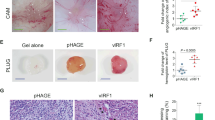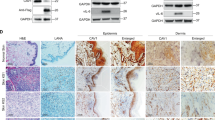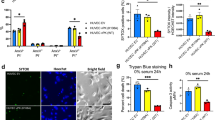Abstract
Kaposi’s sarcoma-associated herpesvirus (KSHV) K13/vFLIP (viral Flice-inhibitory protein) induces transcription of numerous genes through NF-κB activation, including pro-inflammatory cytokines, which contribute to the pathogenesis of Kaposi’s sarcoma (KS). In this study, we report that KSHV vFLIP induces the expression of the NF-κB regulatory proteins A20, ABIN-1 and ABIN-3 (A20-binding NF-κB inhibitors) in primary human endothelial cells, and that KS spindle cells express A20 in KS tissue. In reporter assays, A20 strongly impaired vFLIP-induced NF-κB activation in 293T cells, but ABIN-1 and ABIN-3 did not. Mutational analysis established that the C-terminal domain (residues 427–790) is critical for A20 modulation of NF-κB, but the ubiquitin-editing OTU (ovarian tumor) domain is not. In functional assays, A20 inhibited vFLIP-induced expression of the chemokine IP-10, reduced vFLIP-induced cell proliferation and increased IKK1 protein levels. Thus, we demonstrate that A20 negatively regulates NF-κB activation directly induced by KSHV vFLIP. By attenuating excessive and prolonged vFLIP-induced NF-κB activation that could be harmful to KSHV-infected cells, A20 likely has an important role in the pathogenesis of KSHV-associated diseases, in which vFLIP is expressed.
This is a preview of subscription content, access via your institution
Access options
Subscribe to this journal
Receive 50 print issues and online access
$259.00 per year
only $5.18 per issue
Buy this article
- Purchase on Springer Link
- Instant access to full article PDF
Prices may be subject to local taxes which are calculated during checkout





Similar content being viewed by others
References
Ambinder RF, Cesarman E . Clinical and pathological aspects of EBV and KSHV infection. In: Arvin A, Campadelli-Fiume G, Mocarski E, Moore PS, Roizman B, Whitley R, Yamanishi K Human Herpesviruses: Biology, Therapy, and Immunoprophylaxis Chapter 50. Cambridge: Cambridge University Press,, 2007.
Uldrick TS, Wang V, O’Mahony D, Aleman K, Wyvill KM, Marshall V et al. An interleukin-6-related systemic inflammatory syndrome in patients co-infected with Kaposi sarcoma-associated herpesvirus and HIV but without Multicentric Castleman disease. Clin Infect Dis 2010; 51: 350–358.
Schulz TF, Chang Y . KSHV gene expression and regulation. In: Arvin A, Campadelli-Fiume G, Mocarski E, Moore PS, Roizman B, Whitley R, Yamanishi K Human Herpesviruses: Biology, Therapy, and Immunoprophylaxis Chapter 28. Cambridge: Cambridge University Press,, 2007.
Grundhoff A, Ganem D . Mechanisms governing expression of the v-FLIP gene of Kaposi’s sarcoma-associated herpesvirus. J Virol 2001; 75: 1857–1863.
Chugh P, Matta H, Schamus S, Zachariah S, Kumar A, Richardson JA et al. Constitutive NF-kappaB activation, normal Fas-induced apoptosis, and increased incidence of lymphoma in human herpes virus 8 K13 transgenic mice. Proc Natl Acad Sci USA 2005; 102: 12885–12890.
Ballon G, Chen K, Perez R, Tam W, Cesarman E . Kaposi sarcoma herpesvirus (KSHV) vFLIP oncoprotein induces B cell transdifferentiation and tumorigenesis in mice. J Clin Invest 2011; 121: 1141–1153.
Chaudhary PM, Jasmin A, Eby MT, Hood L . Modulation of the NF-kappa B pathway by virally encoded death effector domains-containing proteins. Oncogene 1999; 18: 5738–5746.
Ganem D . KSHV infection and the pathogenesis of Kaposi’s sarcoma. Annu Rev Pathol 2006; 1: 273–296.
Guasparri I, Keller SA, Cesarman E . KSHV vFLIP is essential for the survival of infected lymphoma cells. J Exp Med 2004; 199: 993–1003.
Liu L, Eby MT, Rathore N, Sinha SK, Kumar A, Chaudhary PM . The human herpes virus 8-encoded viral FLICE inhibitory protein physically associates with and persistently activates the Ikappa B kinase complex. J Biol Chem 2002; 277: 13745–13751.
Field N, Low W, Daniels M, Howell S, Daviet L, Boshoff C et al. KSHV vFLIP binds to IKK-gamma to activate IKK. J Cell Sci 2003; 116(Pt 18): 3721–3728.
Bagneris C, Ageichik AV, Cronin N, Wallace B, Collins M, Boshoff C et al. Crystal structure of a vFlip-IKKgamma complex: insights into viral activation of the IKK signalosome. Mol Cell 2008; 30: 620–631.
Hacker H, Karin M . Regulation and function of IKK and IKK-related kinases. Sci STKE 2006; 2006: re13.
Harhaj EW, Sun SC . IKKgamma serves as a docking subunit of the IkappaB kinase (IKK) and mediates interaction of IKK with the human T-cell leukemia virus Tax protein. J Biol Chem 1999; 274: 22911–22914.
Li XH, Fang X, Gaynor RB . Role of IKKgamma/nemo in assembly of the Ikappa B kinase complex. J Biol Chem 2001; 276: 4494–4500.
Yamaoka S, Courtois G, Bessia C, Whiteside ST, Weil R, Agou F et al. Complementation cloning of NEMO, a component of the IkappaB kinase complex essential for NF-kappaB activation. Cell 1998; 93: 1231–1240.
Baeuerle PA, Baltimore D . I kappa B: a specific inhibitor of the NF-kappa B transcription factor. Science 1988; 242: 540–546.
Grossmann C, Podgrabinska S, Skobe M, Ganem D . Activation of NF-kappaB by the latent vFLIP gene of Kaposi’s sarcoma-associated herpesvirus is required for the spindle shape of virus-infected endothelial cells and contributes to their proinflammatory phenotype. J Virol 2006; 80: 7179–7185.
Matta H, Mazzacurati L, Schamus S, Yang T, Sun Q, Chaudhary PM . Kaposi’s sarcoma-associated herpesvirus (KSHV) oncoprotein K13 bypasses TRAFs and directly interacts with the IkappaB kinase complex to selectively activate NF-kappaB without JNK activation. J Biol Chem 2007; 282: 24858–24865.
Punj V, Matta H, Schamus S, Chaudhary PM . Integrated microarray and multiplex cytokine analyses of Kaposi’s sarcoma associated herpesvirus viral FLICE Inhibitory Protein K13 affected genes and cytokines in human blood vascular endothelial cells. BMC Med Genomics 2009; 2: 50.
Sakakibara S, Pise-Masison CA, Brady JN, Tosato G . Gene regulation and functional alterations induced by Kaposi’s sarcoma-associated herpesvirus-encoded ORFK13/vFLIP in endothelial cells. J Virol 2009; 83: 2140–2153.
Thurau M, Marquardt G, Gonin-Laurent N, Weinlander K, Naschberger E, Jochmann R et al. Viral inhibitor of apoptosis vFLIP/K13 protects endothelial cells against superoxide-induced cell death. J Virol 2009; 83: 598–611.
Matta H, Gopalakrishnan R, Punj V, Yi H, Suo Y, Chaudhary PM . A20 is induced by Kaposi sarcoma-associated herpesvirus-encoded viral FLICE inhibitory protein (vFLIP) K13 and blocks K13-induced nuclear factor-kappaB in a negative feedback manner. J Biol Chem 2011; 286: 21555–21564.
Opipari AW, Boguski MS, Dixit VM . The A20 cDNA induced by tumor necrosis factor alpha encodes a novel type of zinc finger protein. J Biol Chem 1990; 265: 14705–14708.
Opipari AW, Hu HM, Yabkowitz R, Dixit VM . The A20 zinc finger protein protects cells from tumor necrosis factor cytotoxicity. J Biol Chem 1992; 267: 12424–12427.
Cooper JT, Stroka DM, Brostjan C, Palmetshofer A, Bach FH, Ferran C . A20 blocks endothelial cell activation through a NF-kappaB-dependent mechanism. J Biol Chem 1996; 271: 18068–18073.
Krikos A, Laherty CD, Dixit VM . Transcriptional activation of the tumor necrosis factor alpha-inducible zinc finger protein, A20, is mediated by kappa B elements. J Biol Chem 1992; 267: 17971–17976.
Verstrepen L, Verhelst K, van Loo G, Carpentier I, Ley SC, Beyaert R . Expression, biological activities and mechanisms of action of A20 (TNFAIP3). Biochem Pharmacol 2010; 80: 2009–2020.
Wertz IE, O’Rourke KM, Zhou H, Eby M, Aravind L, Seshagiri S et al. De-ubiquitination and ubiquitin ligase domains of A20 downregulate NF-kappaB signalling. Nature 2004; 430: 694–699.
Harhaj EW, Dixit VM . Deubiquitinases in the regulation of NF-kappaB signaling. Cell Res 2010; 21: 22–39.
O’Reilly SM, Moynagh PN . Regulation of Toll-like receptor 4 signalling by A20 zinc finger protein. Biochem Biophys Res Commun 2003; 303: 586–593.
De Valck D, Jin DY, Heyninck K, Van de Craen M, Contreras R, Fiers W et al. The zinc finger protein A20 interacts with a novel anti-apoptotic protein which is cleaved by specific caspases. Oncogene 1999; 18: 4182–4190.
Heyninck K, De Valck D, Vanden Berghe W, Van Criekinge W, Contreras R, Fiers W et al. The zinc finger protein A20 inhibits TNF-induced NF-kappaB-dependent gene expression by interfering with an RIP- or TRAF2-mediated transactivation signal and directly binds to a novel NF-kappaB-inhibiting protein ABIN. J Cell Biol 1999; 145: 1471–1482.
Shembade N, Parvatiyar K, Harhaj NS, Harhaj EW . The ubiquitin-editing enzyme A20 requires RNF11 to downregulate NF-kappaB signalling. EMBO J 2009; 28: 513–522.
Song HY, Rothe M, Goeddel DV . The tumor necrosis factor-inducible zinc finger protein A20 interacts with TRAF1/TRAF2 and inhibits NF-kappaB activation. Proc Natl Acad Sci USA 1996; 93: 6721–6725.
Wullaert A, Verstrepen L, Van Huffel S, Adib-Conquy M, Cornelis S, Kreike M et al. LIND/ABIN-3 is a novel lipopolysaccharide-inducible inhibitor of NF-kappaB activation. J Biol Chem 2007; 282: 81–90.
Wagner S, Carpentier I, Rogov V, Kreike M, Ikeda F, Lohr F et al. Ubiquitin binding mediates the NF-kappaB inhibitory potential of ABIN proteins. Oncogene 2008; 27: 3739–3745.
Mauro C, Pacifico F, Lavorgna A, Mellone S, Iannetti A, Acquaviva R et al. ABIN-1 binds to NEMO/IKKgamma and co-operates with A20 in inhibiting NF-kappaB. J Biol Chem 2006; 281: 18482–18488.
Weaver BK, Bohn E, Judd BA, Gil MP, Schreiber RD . ABIN-3: a molecular basis for species divergence in interleukin-10-induced anti-inflammatory actions. Mol Cell Biol 2007; 27: 4603–4616.
Shembade N, Ma A, Harhaj EW . Inhibition of NF-kappaB signaling by A20 through disruption of ubiquitin enzyme complexes. Science 2010; 327: 1135–1139.
Ohmori Y, Hamilton TA . Cooperative interaction between interferon (IFN) stimulus response element and kappa B sequence motifs controls IFN gamma- and lipopolysaccharide-stimulated transcription from the murine IP-10 promoter. J Biol Chem 1993; 268: 6677–6688.
Zhang SQ, Kovalenko A, Cantarella G, Wallach D . Recruitment of the IKK signalosome to the p55 TNF receptor: RIP and A20 bind to NEMO (IKKgamma) upon receptor stimulation. Immunity 2000; 12: 301–311.
Guasparri I, Wu H, Cesarman E . The KSHV oncoprotein vFLIP contains a TRAF-interacting motif and requires TRAF2 and TRAF3 for signalling. EMBO Rep 2006; 7: 114–119.
Stilo R, Varricchio E, Liguoro D, Leonardi A, Vito P . A20 is a negative regulator of BCL10- and CARMA3-mediated activation of NF-kappaB. J Cell Sci 2008; 121(Pt 8): 1165–1171.
Ea CK, Deng L, Xia ZP, Pineda G, Chen ZJ . Activation of IKK by TNFalpha requires site-specific ubiquitination of RIP1 and polyubiquitin binding by NEMO. Mol Cell 2006; 22: 245–257.
Rahighi S, Ikeda F, Kawasaki M, Akutsu M, Suzuki N, Kato R et al. Specific recognition of linear ubiquitin chains by NEMO is important for NF-kappaB activation. Cell 2009; 136: 1098–1109.
Yoshikawa A, Sato Y, Yamashita M, Mimura H, Yamagata A, Fukai S . Crystal structure of the NEMO ubiquitin-binding domain in complex with Lys 63-linked di-ubiquitin. FEBS Lett 2009; 583: 3317–3322.
Hadian K, Griesbach RA, Dornauer S, Wanger TM, Nagel D, Metlitzky M et al. NF-{kappa}B Essential Modulator (NEMO) interaction with linear and Lys-63 ubiquitin chains contributes to NF-{kappa}B activation. J Biol Chem 2011; 286: 26107–26117.
Matta H, Sun Q, Moses G, Chaudhary PM . Molecular genetic analysis of human herpes virus 8-encoded viral FLICE inhibitory protein-induced NF-kappaB activation. J Biol Chem 2003; 278: 52406–52411.
Shembade N, Pujari R, Harhaj NS, Abbott DW, Harhaj EW . The kinase IKKalpha inhibits activation of the transcription factor NF-kappaB by phosphorylating the regulatory molecule TAX1BP1. Nat Immunol 2011; 12: 834–843.
Li Q, Lu Q, Bottero V, Estepa G, Morrison L, Mercurio F et al. Enhanced NF-kappaB activation and cellular function in macrophages lacking IkappaB kinase 1 (IKK1). Proc Natl Acad Sci USA 2005; 102: 12425–12430.
Liu B, Yang Y, Chernishof V, Loo RR, Jang H, Tahk S et al. Proinflammatory stimuli induce IKKalpha-mediated phosphorylation of PIAS1 to restrict inflammation and immunity. Cell 2007; 129: 903–914.
Lee EG, Boone DL, Chai S, Libby SL, Chien M, Lodolce JP et al. Failure to regulate TNF-induced NF-kappaB and cell death responses in A20-deficient mice. Science 2000; 289: 2350–2354.
Boone DL, Turer EE, Lee EG, Ahmad RC, Wheeler MT, Tsui C et al. The ubiquitin-modifying enzyme A20 is required for termination of Toll-like receptor responses. Nat Immunol 2004; 5: 1052–1060.
Daniel S, Arvelo MB, Patel VI, Longo CR, Shrikhande G, Shukri T et al. A20 protects endothelial cells from TNF-, Fas-, and NK-mediated cell death by inhibiting caspase 8 activation. Blood 2004; 104: 2376–2384.
Beyaert R, Heyninck K, Van Huffel S . A20 and A20-binding proteins as cellular inhibitors of nuclear factor-kappa B-dependent gene expression and apoptosis. Biochem Pharmacol 2000; 60: 1143–1151.
Natoli G, Costanzo A, Guido F, Moretti F, Bernardo A, Burgio VL et al. Nuclear factor kB-independent cytoprotective pathways originating at tumor necrosis factor receptor-associated factor 2. J Biol Chem 1998; 273: 31262–31272.
Kato M, Sanada M, Kato I, Sato Y, Takita J, Takeuchi K et al. Frequent inactivation of A20 in B-cell lymphomas. Nature 2009; 459: 712–716.
Compagno M, Lim WK, Grunn A, Nandula SV, Brahmachary M, Shen Q et al. Mutations of multiple genes cause deregulation of NF-kappaB in diffuse large B-cell lymphoma. Nature 2009; 459: 717–721.
Giulino L, Mathew S, Ballon G, Chadburn A, Barouk S, Antonicelli G et al. A20 (TNFAIP3) genetic alterations in EBV-associated AIDS-related lymphoma. Blood 2011; 117: 4852–4854.
Narazaki M, Tosato G . Ligand-induced internalization selects use of common receptor neuropilin-1 by VEGF165 and semaphorin3A. Blood 2006; 107: 3892–3901.
Edgell CJ, McDonald CC, Graham JB . Permanent cell line expressing human factor VIII-related antigen established by hybridization. Proc Natl Acad Sci USA 1983; 80: 3734–3737.
Lin R, Yang L, Nakhaei P, Sun Q, Sharif-Askari E, Julkunen I et al. Negative regulation of the retinoic acid-inducible gene I-induced antiviral state by the ubiquitin-editing protein A20. J Biol Chem 2006; 281: 2095–2103.
Salvucci O, Maric D, Economopoulou M, Sakakibara S, Merlin S, Follenzi A et al. EphrinB reverse signaling contributes to endothelial and mural cell assembly into vascular structures. Blood 2009; 114: 1707–1716.
Sakakibara S, Sakakibara K, Tosato G . NF-kappaB activation stimulates transcription and replication of retrovirus XMRV in human B-lineage and prostate carcinoma cells. J Virol 2011; 85: 3179–3186.
Acknowledgements
We thank G Nolan (Stanford University), BK Weaver (Missouri State University), J-M Peloponese Jr, K-T Jeang (NIAID, NIH), DB Conze, JD Ashwell (NCI, NIH), AV Grishin (University of Southern California), A Leonardi (University of Naples, Italy), R Lin (Jewish General Hospital, Canada) for reagents; the patients who volunteered for this study; Dr MN Polizzotto (NCI, NIH), K Aleman and K Wyvill for patient care; the Confocal Microscopy Core Facility (Laboratory of Experimental Carcinogenesis, CCR, NCI) for providing LSM510 and the DNA Minicore Facility (Laboratory of Experimental Carcinogenesis, CCR, NCI) for DNA sequencing, and K Sakakibara (NCI, NIH) for her help in reporter assay. We also thank Drs D Lowy, O Salvucci, H Ohnuki and all members of Laboratory of Cellular Oncology Branch for their advice and help on this work. This study was supported by the intramural research program in Center for Cancer Research, National Cancer Institute, National Institutes of Health, Bethesda, MD20892, USA.
Author information
Authors and Affiliations
Corresponding author
Ethics declarations
Competing interests
The authors declare no conflict of interest.
Rights and permissions
About this article
Cite this article
Sakakibara, S., Espigol-Frigole, G., Gasperini, P. et al. A20/TNFAIP3 inhibits NF-κB activation induced by the Kaposi’s sarcoma-associated herpesvirus vFLIP oncoprotein. Oncogene 32, 1223–1232 (2013). https://doi.org/10.1038/onc.2012.145
Received:
Revised:
Accepted:
Published:
Issue Date:
DOI: https://doi.org/10.1038/onc.2012.145
Keywords
This article is cited by
-
TNFAIP3 mediates FGFR1 activation-induced breast cancer angiogenesis by promoting VEGFA expression and secretion
Clinical and Translational Oncology (2022)
-
The interplay between EBV and KSHV viral products and NF-κB pathway in oncogenesis
Infectious Agents and Cancer (2020)
-
C11orf95–RELA fusion present in a primary supratentorial ependymoma and recurrent sarcoma
Brain Tumor Pathology (2015)
-
Biphasic regulation of A20 gene expression during human cytomegalovirus infection
Virology Journal (2014)



